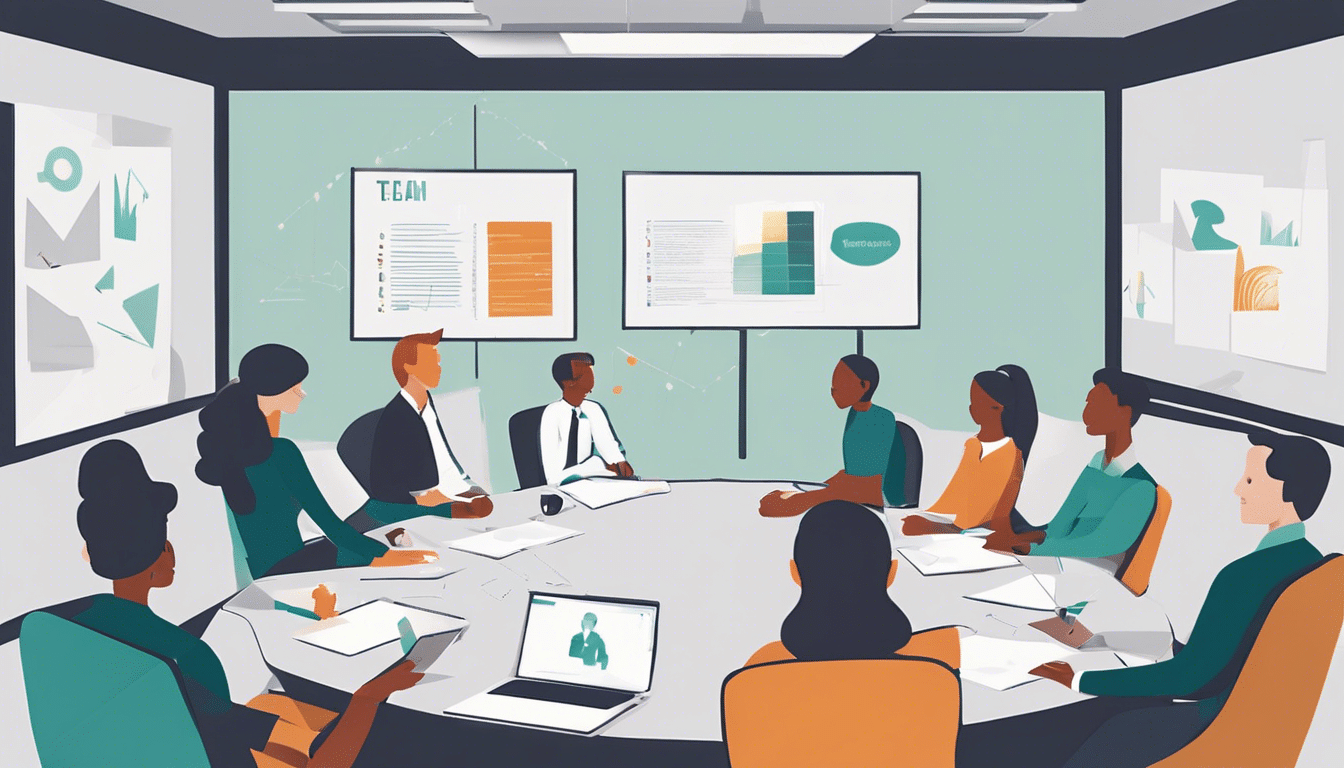You found our list of team meeting tips.
Team meeting tips are strategies that make team meetings more effective. For example, setting clear objectives, maintaining focus, and ensuring active participation. The purpose of these strategies is to streamline communication. These strategies are also known as “how to host team meetings” and “effective meeting steps.”
These team meeting tips are similar to team meeting ideas, opening and closing remarks, ways to run hybrid meetings, and all hands meeting ideas.
This list includes:
- best practices for team meetings
- team meeting techniques
- effective meeting steps
- productive team meetings
- helpful tips for team meetings
- how to host team meetings
Let’s get to it!
List of team meeting tips
From setting clear objectives to ensuring active participation, here is our list of tips to improve team meetings.
1. Clear Objectives
Having clear objectives for each team meeting is crucial. This step helps maintain focus, encourages effective communication, and enhances productivity. A goal-oriented approach helps stimulate productive discussions. The team will be able to concentrate on accomplishing tasks instead of veering off topic. Plus, outlining goals ensures the whole team is on the same page.

2. Setting Agenda
Setting an agenda is one of the team meeting techniques that encourages efficiency. This outline highlights the meeting’s purpose and specifies what attendees need to discuss. Sharing the agenda in advance allows team members to prepare. A well-planned agenda keeps the meeting focused, preventing unnecessary diversions. Teams will be able to have productive conversations and save time.
Here are conference agenda examples.
Get our free team building toolbox
- icebreaker games
- bingo cards
- DIY guides
 by teams at FedEx, Amazon, Deloitte and 73,930+ others
by teams at FedEx, Amazon, Deloitte and 73,930+ others

3. Proper Timing
Being on time is crucial in team meetings, as it can impact productivity and engagement. Starting promptly shows respect for attendees’ schedules and sets a positive tone for the discussion. Also, the length of the meeting should allow enough time to cover important topics. However, discussions should be short enough that groups can stay focused. Another important consideration is offering breaks. This time provides breathing room and prevents sessions from becoming overwhelming. Being mindful of timing enhances the effectiveness of team meetings.
Learn time management tips.
4. Role Assignment
Assigning effective roles is crucial for smooth team meetings. Attendees should each have a designated job, such as taking notes, leading the discussion, or keeping track of time. This step fosters responsibility and engagement. A good structure allows each meeting to be more productive.
5. Prior Preparation
Effective preparation before team meetings is one of the most effective meeting steps. Hosts can outline the agenda, gather necessary materials, and set clear objectives. This preparation improves productivity and engagement among team members. The whole team will have all the right information, including the meeting’s purpose. As a result, teams have focused discussions that help them reach decisions.
6. Active Participation
Every team member should participate in discussions during team meetings. Being active in meetings fosters engagement and promotes a shared understanding. Equal participation can reveal hidden talents and invite innovative ideas. Working together during group meetings improves team spirit, productivity, and success.
7. Technology Utilization
Using technology in team meetings can enhance productivity. Tools include video conferencing software, project management apps, and collaborative platforms. These programs can streamline communication and foster team collaboration. Plus, this tech can document information effectively. Using the right technology ramps up effectiveness, saving time and ensuring inclusivity.
8. Meeting Recap
Following the meeting, it is helpful to provide a clear recap. This summary keeps team members informed of the discussions, decisions, and tasks. Summaries should include action items, deadlines, and responsible individuals. This step promotes effective communication within the team.
9. Focus Maintenance
Your team can stay concentrated during meetings by minimizing distractions. For instance, attendees can set their phones to silent, avoid side conversations, or use tools to limit online distractions. Regular breaks can also help maintain focus, preventing overload and increasing productivity. These tips can help your team stay attentive and have productive team meetings.
10. Feedback Reception
Receiving feedback is crucial during team meetings. This step allows team members to share their thoughts and perspectives. Listening to feedback promotes open communication and collaboration within the team. Valuing and acting on feedback improve team performance and results. These opinions are vital for ongoing improvement and growth.
Read employee feedback tips.
11. Creative Triggers
Creative triggers are prompts that inspire innovative ideas and solutions during team meetings. These triggers can range from brainstorming exercises to visual aids or even music. Teams can break out of routine thinking patterns and see new perspectives on challenges they face. These tools can create a more dynamic and engaging meeting environment.
12. Conflict Resolution
Conflict resolution is an important part of creating a strong team environment. During meetings, the environment should encourage communication. Team members should be able to voice concerns without fear of judgment. It is also vital to address and resolve conflicts promptly and fairly. This technique protects productivity and team spirit.
Check out this list of conflict resolution activities.
13. Punctuality
When wondering how to host team meetings, be sure to be on time. Punctuality shows respect for each attendee’s time and contributes to a productive environment. Arriving late can cause disruption, delay important discussions, and lead to missed information. To ensure smooth meetings, try to be on time or even a few minutes early.
14. Transparent Communication
Clear communication fosters trust within a team, preventing misunderstandings and confusion. During meetings, encourage members to voice their thoughts without hesitation. Active listening is also essential, and workers should seek clarification when needed. This type of communication can result in successful outcomes.
Here are internal communication tips.
15. Inclusion Culture
Inclusion culture fosters diverse perspectives and encourages open communication. You can add this culture to your team meetings by giving all members equal opportunities to share their ideas freely. Hosts should encourage active participation and promote respect for each attendee’s opinions. This environment strengthens team cohesion, creativity, and productivity.
Learn tips for inclusive workplaces.
16. Decision Recording
One of the most helpful tips for team meetings is keeping a detailed record of all decisions. This record ensures transparency and makes future reference easier. In these notes, list who was present, the decisions made, and any actionable steps moving forward. This record allows for greater accountability and helps any worker who was not present. A well-documented meeting can provide valuable insights over time.
17. Motivational Tactics
You can encourage your team during meetings using motivational tactics. Success stories, attainable goals, and praise for a job well done can inspire attendees. In addition, show genuine interest in workers’ ideas and do fun team building activities. These methods boost morale and create a positive and productive work environment.
Find out more ways to motivate employees.
18. Goal Alignment
Team members should understand and embrace the company’s goals. Setting aside a part of your team meeting to review these objectives can keep teams on target. Diverse perspectives can offer fresh insights toward achievement. Regular check-ins on goal alignment can improve team performance.
Here is a list of goal setting activities.
19. Follow Up Strategy
A follow-up plan keeps teams on track and responsible. This plan includes recording action items, assigning tasks, and establishing deadlines for completion. By putting a follow-up plan into action, teams can monitor progress and tackle any challenges that come up. This method promotes openness, improves communication, and results in greater productivity.
20. Meeting Evaluation
Evaluating a meeting requires feedback from all participants. Surveys, verbal discussions, or written reflections can help share your team’s thoughts. Questions about the meeting’s structure, content, and effectiveness also offer valuable insights. Analyzing successes and areas for enhancement aids in planning future productive meetings. Feedback is among the best practices for team meetings and plays a vital role in growth and development.
Final Thoughts
Using these team meeting tips can improve how well your team works together. These techniques help make communication smoother and encourage groups to work together better. Following these tips makes meetings more useful, helping teams reach their goals faster and with less trouble. When trying to host a successful meeting, being ready and following up can lead to success.
Next, check out our posts on Zoom icebreaker questions, morning meeting games, and virtual team games.



